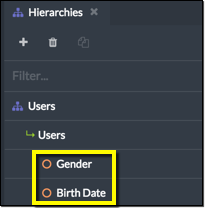About Dimension Attributes
A dimension attribute represents a single data element in the dimension, and is linked to one or more columns of an underlying dataset. There are two kinds of dimension attributes: level attributes and secondary attributes.
WARNING: AtScale does NOT recommend mapping a level key or a dimensional attribute key to a floating point number data warehouse column. Doing so will prevent AtScale from applying certain performance optimizations. This is especially applicable to large result sets for Excel queries, but applies to all business intelligence tool queries.
Level Attributes
Level attributes are those that are associated with a particular hierarchy. Every hierarchy has a key level attribute, which is the most granular representation of the dimension's data. Only level attributes can be used to define relationships between datasets and other dimensions.
For example, in this Geography dimension hierarchy, there are four level attributes (Country, State, City, and GeoKey), which are each associated with one or more underlying data columns.

Secondary Attributes
Dimension attributes that are not the dimension's key, and not a level of a hierarchy are called secondary attributes. For example, Gender and Birth Date are attributes about a user, but they don't make sense as part of a hierarchy.
A secondary attribute cannot be used to define relationships, but the level they are connected to can be.
Note: As of AtScale 2021.3.0 it is possible to build tabular reports that use hierarchy-specific calculations, such as Time Calculations, without specifying the Hierarchy in the report or query. See the Level Alias documentation for more information.

Using Dimension Attributes in Calculated Measures
You can evaluate dimension attribute values in a calculated measure formula. Doing so is useful for conditional processing of measure values based on the value of a given dimension attribute. For more information, including the syntax to use, see CURRENTMEMBER.NAME in AtScale's MDX reference.